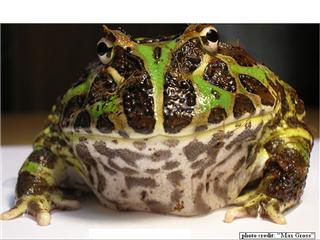Monster frog of Gondwana
A fossil of a South American frog family has been found in Madagaskar, says S.Ananthanarayanan.
Scientists from Stony Brook University have found the remains of what may be the largest frog that ever lived. The fossil was found
in strata relating to the late cretaceous period, some 70 million years ago. The interesting thing is that close relatives of the ancient discovery are currently found in distant South America.
Ceratophrys or horned frogs
Ceratophrys is a genus of frogs also known as the South American Horned Frogs or Pacman frogs, because of their very large mouths. These frogs are found in the rain forests
of Argentina, Uruguay and Brazil. The Pacman is a voracious eater and tries to gobble up anything that moves near its enormous mouth, like insects, small birds, mammals, lizards or other frogs. In fact, the frog has been found dead in the wild, asphyxiated
by its own meal!

The frogs grow to be 10-15 cms in size and their most prominent feature is the mouth, which is about half the animal’s size. It hunts
by being motionless and waiting for prey - which is anything that can fit in its mouth.
The Devil Toad
Stony Brook paleontologist David Krause first found large frog bones in Madagaskar in 1993. The stratum dated to the cretaceous,
or 70 million years ago and the frog remains were among dinosaur and crocodile fossils. Krause’ team recently had enough frog bones to piece together, and then to propose what the creature looked like and may have weighed. The animal was 16 inches (40 cms)
across and weighed 5 kg and had heavy armour and teeth. The teeth and powerful jaws suggest that the frog could kill and eat most small vertebrates and even new-born dinosaurs! The picture is so formidable that the scientists have dubbed the frog
Beelzebufo, or devil toad.
But another feature of the frog’s bones is that they resemble those of the South American horned Pacman and it did not take long
for frog fossil experts Susan Evans and Mark Jones to identify the ancient frogs of Madagaskar and the animals of South America as close relatives!

This is yet another instance of common or closely related plant and animal species being found off the African coast and in South
America, to suggest that the two regions were once land-linked.
Gondwanaland
There is geological evidence that the land masses of Australasia, Antarctica, South Africa, Madagascar, India and South America were
once part of a single continent that geologists call Gonwanaland or Gondwana.
While the great mass was afloat upon the molten mantle below, about 70 million years ago, Gondwana began to break up under the effects of the shifting base.
Perhaps mantle plumes, which are rising currents of moten rock, softened thinner parts of the crust and caused fissures, perhaps the heat and energy caused stress that cause fractures, but Gonwana began to separate into bits.
To conserve the energy spent, the bits began to drift and large portions formed the continents of Antarctica, Australia, South America,
South Africa, the Indian sub-continent. The African continent separated first, and from it the South American mass. Antarctica remained almost stationary, while India-Madasgascar and Australia broke off later. India-Madagascar-Seychelles separated and the
landmasses moved considerable distances, some earlier, some later.
Important supporting evidence is the flora and fauna, displaying common ancestry, which are common and unique to these present-day
continents. For example, marsupials are found both in Australia and South America. A family of flowering plants, known as Proteaceae, are found in Australia, South and Central Africa, South and Central America, India, Eastern and South-eastern Asia. Proteaceous
pollen is abundant in coal deposits more than 90 million years old, which indicates the period when the pollen spread to these then connected land masses.
In this context, the discovery of the Devil Toad in Madagaskar is a convincing piece of evidence – a genus that once lived and went extinct in the East thrived and is abundant in South America! The discovery
has been reported in the journal, Proceedings of the National Academy of Sciences, on 26th Feb 2008. The study was also funded by the
National Geographic Society.
[the writer can be contacted at simplescience@gmail.com]